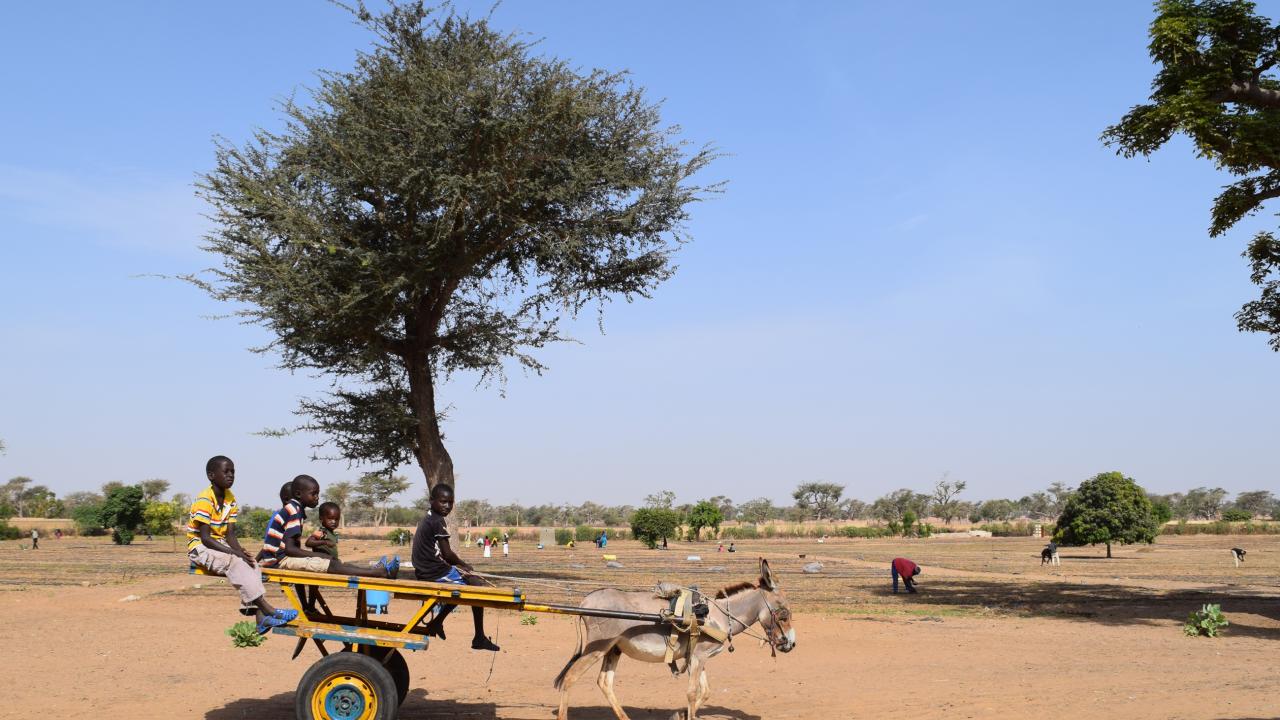
Collective Action for Drip Irrigation Takes Off in Senegal
By Jozefina Kalaj, The George Washington University
In 2015, our group of researchers drove two hours east of Dakar to survey farmers in the village of Touba Toul. It was my first trip to Senegal. The landscape was less pristine than I had imagined, but the air was filled with the scent of freshly picked mangos.
It was still early morning when we arrived at the PAPSEN model farm site, which spans about five hectares at the edge of the village and is shared by 50 households who each manage individual plots. Outside the entrance stood a sign noting the partnership between the three countries supporting the project: Senegal, Italy and Israel.
Construction of a drip irrigation system had been completed at the start of 2015 and by the time of our visit in mid-summer, farmers had already harvested onions and were planting okra. Every plot was being actively worked, and many had more than one person weeding, fertilizing or sowing.
I spent the following days observing the workings of this vibrant model farm and talking to farmers about the project’s impact on their farming practices and on their lives. Through these discussions, I learned about the history of this agriculture group.
Twenty years ago when the Spanish Red Cross helped to drill a borehole for increased water access, the farmers of the village — men and women — joined together into a collective and began to grow crops. Using watering cans to irrigate, the group started growing vegetables during the dry season. In addition to a lack of information about new farming practices, the farmers also noted that time and backbreaking labor were slowing their progress and hindering their production over the years.
Farmers involved in this current drip irrigation project said that the new method of crop watering has now made their farming easier. Their first onion crop using the drip irrigation system was the best harvest they had ever had. Many showed me the onions they had just picked and explained the proper drying and storing practices they learned during training.
This model farm is part of a larger impact evaluation funded by the Feed the Future Innovation Lab for Assets and Market Access. The study seeks to rigorously evaluate the impacts of these interventions on the production, income, time use, nutrition and social capital of these smallholder farmers. The sustainability of this intervention will depend heavily on the group’s ability to collaborate and plan ahead for maintenance and repairs to the system.
Given that collective action challenges are common in cooperative production settings, the project has developed and continues to test tools to ease those challenges. One such mechanism is the installation of individual plot switches and water meters. Another is encouraging and assisting each group in opening two bank accounts — one to collect input costs and the other to save for repairs.
I returned to Senegal in January 2016, eight months after my initial visit and found time to once again visit the farmers in Touba Toul. It was citrus season and the once heaping mango baskets were now filled with tangerines and oranges.
The model site was as vibrant as I remembered. A farmer who was working at a plot close to the entrance came to greet us. He was preparing the soil for planting, and it was evident he had been working hard. The soil ridges on his plot were wider and higher than in other ones. He noted that this was a technique he uses for planting onions, since they need a lot of loose warm soil at the surface.
At a nearby plot, a middle-aged farmer was sitting on the ground sorting through onion seedlings as she gave instructions to family members who were planting.
Before the irrigation system was put in place, it was difficult for her to help out with the family’s farm work since irrigating with watering cans was too hard physically. Now she really enjoyed working at the field. She could stop by a couple of hours a day to turn the water on while weeding and taking care of the plants.
Arriving in Touba Toul at the beginning of their third growing season, I wanted to hear how the farmers coped with any problems that arose and how they managed input and repair costs. The agreement within the group was to collect the subsequent season’s input costs after each harvest in addition to paying the water bill and contributing a fixed amount for repairs.
It appeared that the group was handing small repairs, such as leaks and damages caused by rodents, well. But they were less prepared for major unexpected breakdowns, like pump failure.
This fairly simple technology has great potential for poverty alleviation. Yet, in sub-Saharan Africa its adoption is very low and, in some instances, the irrigation system is dismantled some years after being installed. This puzzling behavior has not been rigorously studied, and our evaluation aims to provide some insight.
I left Touba Toul this second time with a better understanding of the tools the farmers needed to sustain the project’s initial promise. The visits also reaffirmed the critical role collective action plays in a cooperative drip irrigation setting.
Jozefina Kalaj is a graduate student at The George Washington University. She is a research assistant on a Feed the Future Innovation Lab for Assets and Market Access project in Senegal to evaluate a PAPSEN intervention that combines a drip irrigation system in a model farm setting with a locally optimized package of improved inputs and intensive extension services. This post originally appeared on Agrilinks.org.
